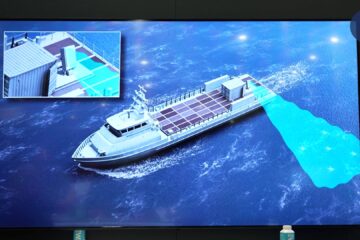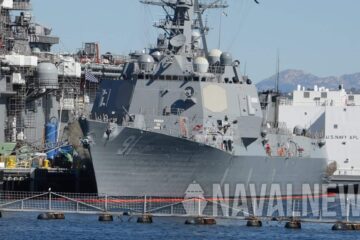Russia launched its newest submarine, the K-571 Krasnoyarsk, in a ceremony on July 30, 2021. The submarine will be armed with three types of cruise missiles as well as regular torpedoes and anti-submarine missiles. The cruise missiles should include the new Zircon hypersonic anti-ship missile which is currently being tested in the Arctic. In total, 32 cruise missiles can be carried.
Krasnoyarsk is a Project 885M ‘Yasen-M’ class boat (aka Severodvinsk-II class), the 3rd of 8 planned. These represent the most modern and powerful attack submarines in the Russian inventory. And they are often described as being on a par with the latest western types. But how do they stack up?
Particularly in weapons terms? Other aspects such as sonar, sensors and stealth are harder to compare given the sensitive nature of these topics. Both submarines are believed to be extremely difficult to counter. The stand-off weapons however are a major component of the submarine’s punch.
The Yasens are essentially cruise missile submarines and are often given the special vessel classification “SSGN“ instead of the vanilla “SSN”. The ‘G’ stands for ‘guided missiles’ and reflects that the cruise missiles are their defining capability. The main Western equivalents, the US Navy’s Virginia Class and the Royal Navy’s Astutes, are significantly smaller. These are termed ‘SSN’s and although they carry Tomahawk cruise missiles, they have a much smaller overall weapons load.
8 Yasen-Ms, 8 Virginia Block Vs
The US Navy is building at least 8 new submarines which are closer equivalent to the Yasen-Ms in terms of weapons load. Eight out of ten of the new Block V Virginia Class will have additional missile tubes. This will give them an impressive 76% increase in weapons over the current Virginias. All these extra slots are in a new vertical launch systems which is optimized for cruise missiles. This will increase the number of cruise missiles in a standard load-out from 12 to 40. Added to this the slots in the torpedo room (which would not normally carry cruise missiles) and there are a total of 66 weapons aboard.
The Yasen-M however still has more total slots at around 72 torpedo-sized weapons. Fewer of these are in the vertical launch tubes however. The torpedo room is much larger and has 10 torpedo tubes (some reports 8) versus 4 on the Virginias. A comparison can be made to the Seawolf class in fact which has a similar torpedo layout. The Yasen’s torpedo room will extend over two decks.
Cruise Missile Mixes
The Yasen-M’s 32 vertical tubes can accommodate three missile types. On paper this versatility could convey an advantage although the performance of the US Navy’s Tomahawk cruise missiles is hard to dispute.
The Russian equivalent to the Tomahawk is the 3M14K Kalibr (NATO: SS-N-30A SIZZLER). This long-ranged subsonic missile has been tested in combat conditions in Syria. It can now be considered a mature system and several older Russian submarines are also being upgraded to carry it.
The second Russian missile type is the P-800 (3M55) Oniks (NATO: SS-N-26 STROBILE). This is a supersonic missile, generally with a shorter range than the Kalibr. Although there have been occasional reports of a longer-range version. Onik’s primary targets are high-value warships but it can also hit land targets.
Finally there is the new 3M22 Zircon. This is a hypersonic anti-ship missile which is currently being tested. Zircon will set the Russian submarines apart, particularly in anti-ship strike, but the US Navy is also planning to field hypersonic missiles.
And the Yasen-M has a stronger emphasis on anti-ship cruise missiles. The latest Tomahawk missile, coincidently also called the ‘Block V’, reintroduces the anti-ship role. It is a dual-purpose weapon and retains its land-attack credentials.
The US Navy currently also operates four converted Ohio Class ballistic missile submarines in the SSGN role. These carry an unparalleled weapons load thanks to the massive capacity of their legacy missile silos. These however are in their final years and will be long out-lived by the Yasens and Virginias. The Block V will be the closest that the US Navy has to an SSGN when it enters service.
The Yasen-M Class boats are larger and carry more weapons than their western equivalents. They will also be quicker to field hypersonic weapons (although service introduction is going slower than previously reported). But they carry fewer cruise missiles than the enlarged Block V Virginia Class. This will significantly narrow the gap even before the US Navy adds hypersonic weapons and the anti-ship capable Tomahawks.






